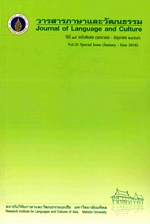International and intercultural communication in Great King Naresuan Period
Main Article Content
Abstract
The Memoirs of King Naresuan’s period has enormous evidences and has been distributed in various formats in mass media. Almost all of them, whether in Thai language or others, cover his brave heart, defeat of enemies, expansion of border, as well as his influence on healthcare, language education and religious acts. Nonetheless, personal communication is sometimes understood differently between people who share different backgrounds, cultural practices and religious beliefs. King Naresuan felt challenged by these factors and it let him to investigate and to create an understanding of how to communicate with different parties, resulting in good relations with everyone. The objective of this qualitative study is to find and identify a pattern of international communication in the low – technology period of King Naresuan, derived from secondary data about him which involve diplomatic and personal communications with international partners. According to international communication, intercultural communication and communication process are being used to explain the context of e.g. political texts, and poses the questions; what was important? To whom is it important? For what is a purpose? The results show that ancient people mitigating circumstances while looking for new land and resources, the main reasons for war, had a diplomatic and soft approach – e.g. marriage, offering of souvenirs and so on. Their international communications abilities are one of the success factors strengthening their power, keeping dependent landlords under their control.
Article Details
The articles featured in the Journal of Language and Culture (JLC) constitute academic works representing the viewpoints of the respective author(s). It is crucial to note that these opinions do not necessarily reflect those of the Editorial Board.
All articles published in JLC are released under the Creative Commons Attribution 4.0 International License (CC BY 4.0). This license grants permission for unrestricted use, distribution, and reproduction in any medium, provided proper credit is given to the original author(s) and the source.
References
Claudio Baradi. (2006). New Forms of Intercultural Communication in a globalized world. The international communication Gazette, 68(1).53-69.
DeWan Gibson & Mei Zhong. (2005). Intercultural Communication Competence in the healthcare context. International Journal of Intercultural Relations. (29), 621-634.
Edward T.Hall. (1976, 1981). Beyond Culture. Anchor books / Doubleday.
Everett M. Rogers, William B. Hart & Yoshitaka Miike. (2002). Edward T.Hall and The History of Intercultural Communication: The United States and Japan. Keio Communication Review, 24, 3-26.
Fred E. Jandt. (2004). An introduction to intercultural communication: Identities in a global community. (4th edition). London: Sage Publication.
Geert Hofstede & Gert Jan Hofstede. (2005). Cultures and organizations: software of the mind. Revised and Expanded 2nd edition, The McGrawHill Companies.
Guo-Ming Chen. (1992). A test of intercultural communication competence. Intercultural Communication Studies II. (2), 63-82.
JudithA. Sanders & Richard L. Wiseman. (1993). Uncertainty Reduction Among Ethnicities in the United States. Intercultural Communication Studies III. (1), 1-13.
Judy Pearson, Paul Nelson, Scott Titsworth& Lynn Harter. (2003). Human Communication. McGraw – Hill Higher Education.
Michael Brein & Kenneth H. David. (1971). Intercultural communication and the adjustment of the sourjourner. Psychological Bulletin, 76(3), 215-230.
Michael W. Kramer. (1993). Communication and Uncertainty Reduction during Job Transfers: Leaving and Joining Processes. Communication Monographs, 60, 178-198.
Ming-Yi Wu. (2006). Hofstede’s Cultural Dimension 30 Years Later: A Study of Taiwan and the United States. Intercultural Communication Studies, 15(1), 33-42.
Robert S. Fostner. (1993). International communication: History, conflict, and control of the global metropolis. USA: Wadsworth Publishing Company.
Tony Fang. (2003). A Critique of Hofstede’s Fifth National Culture Dimension. International Journal of Cross Cultural Management, 3(3), 347-368.
Xiaoping Jiang. (2006). Towards intercultural communication: from micro to macro perspectives. Intercultural Education. 17(4), 407-419.


